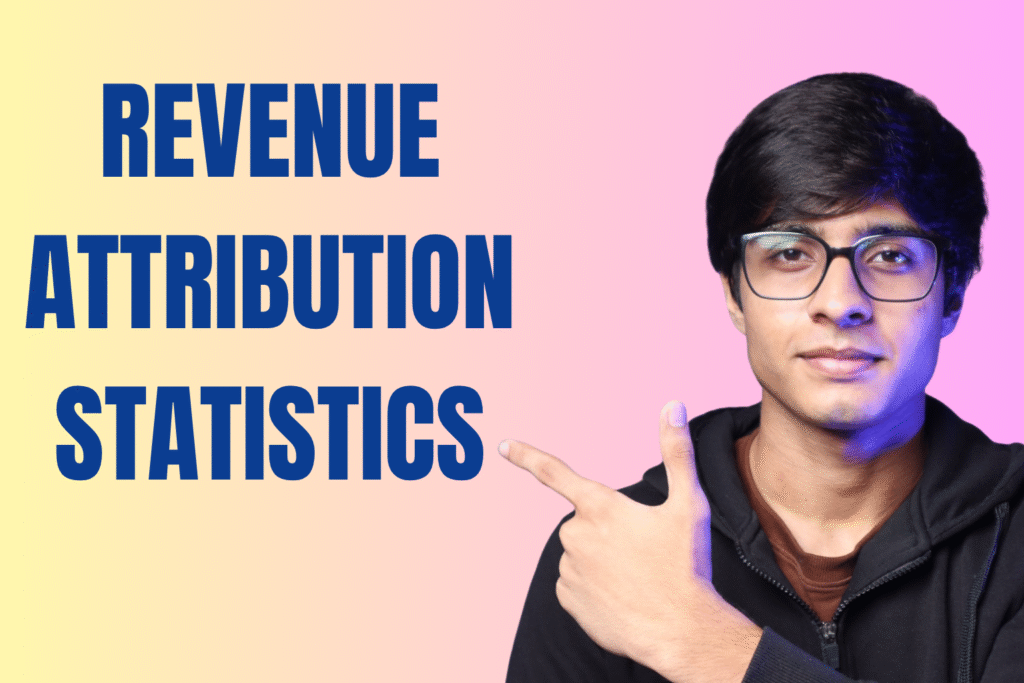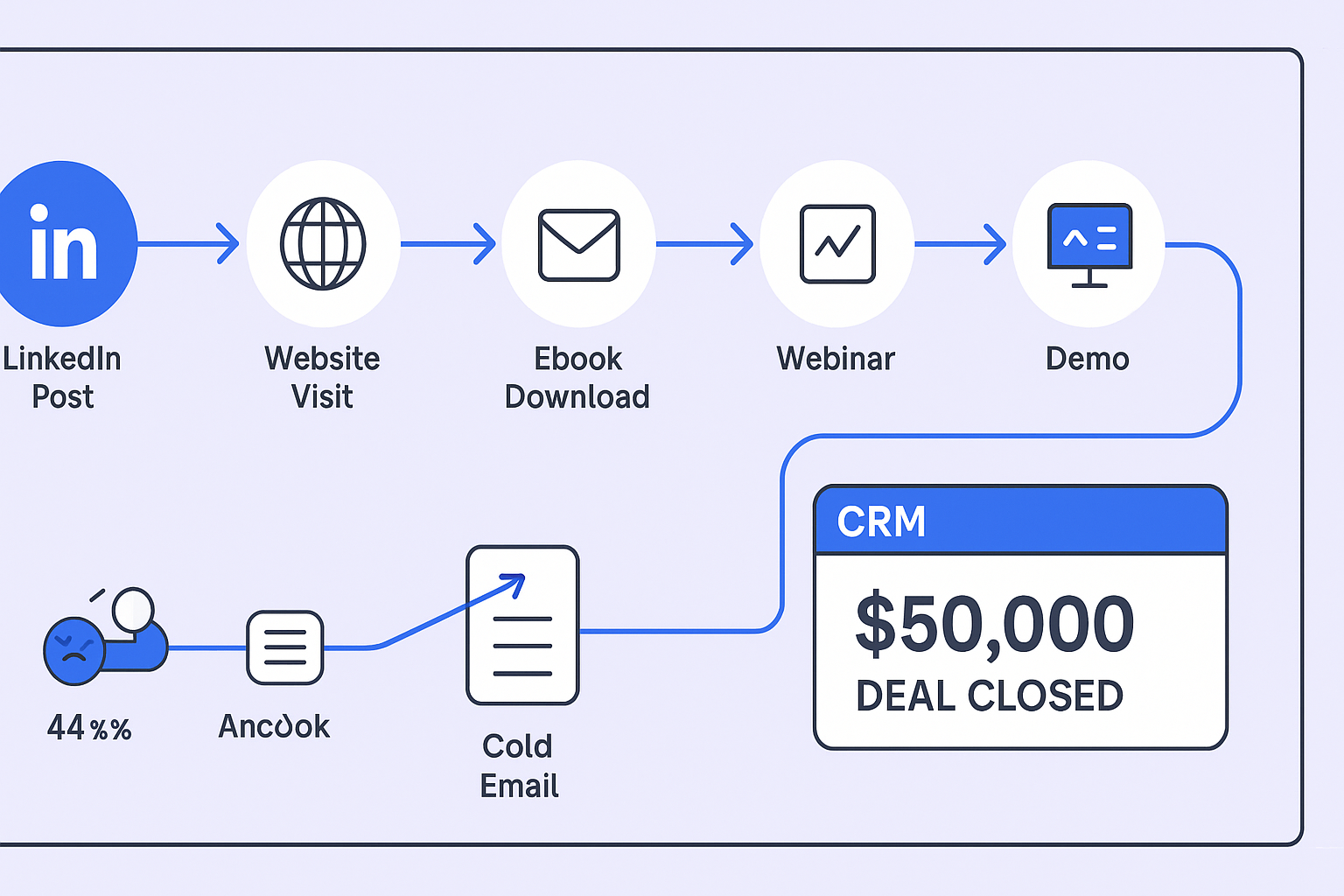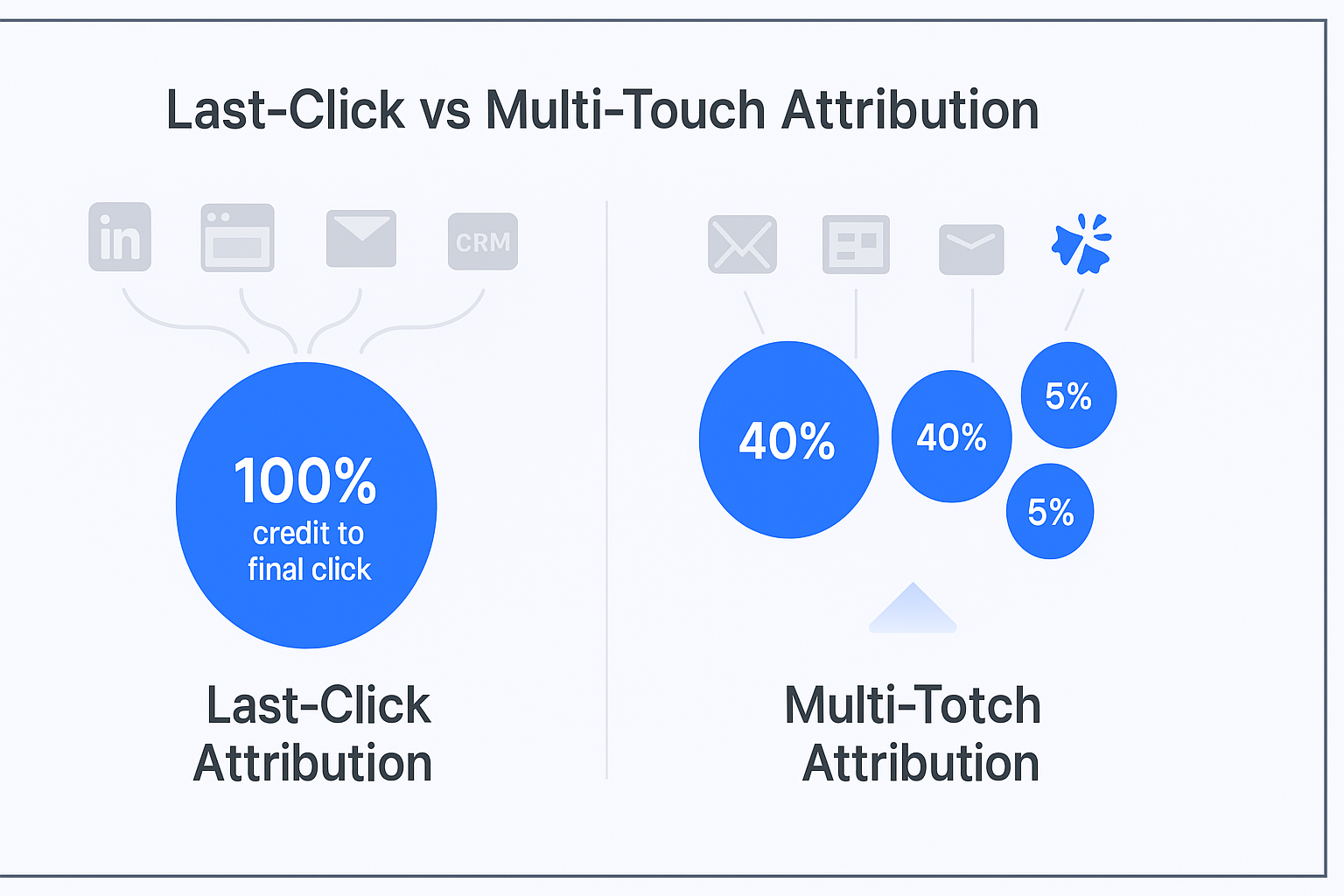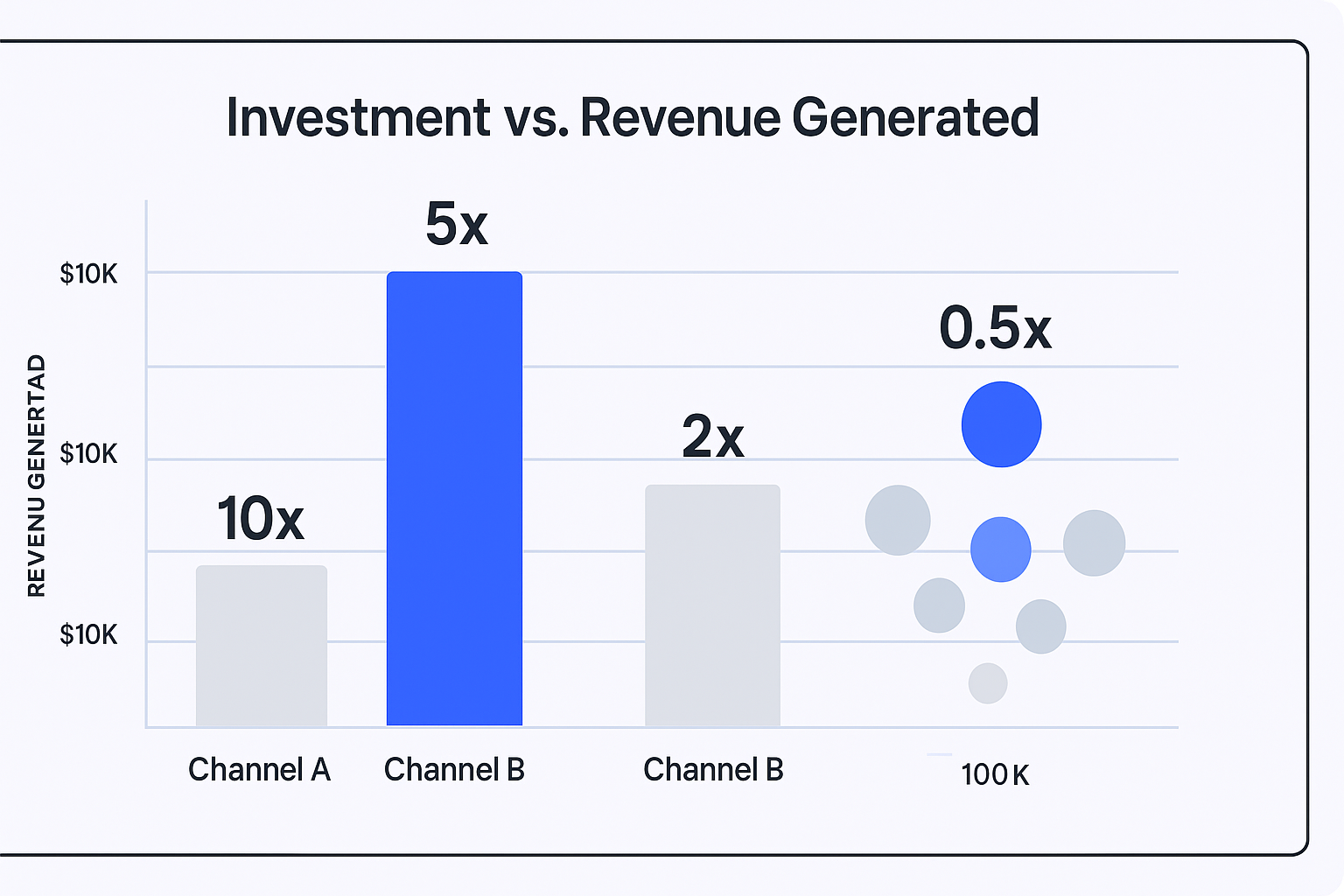- blog
- Statistics
- Revenue Attribution Statistics 2025 | Track Marketing ROI

Revenue Attribution Statistics: Stop Guessing Your Marketing ROI in 2025
Table of Contents
Revenue Attribution Statistics
- Accurate attribution across marketing channels can boost efficiency by 15% to 30%, leaving money on the table without it
- 75% of companies now use multi-touch attribution models to measure performance instead of single-touch methods
- 41% of marketers still use Last-Touch attribution for online campaigns, ignoring the customer journey complexity
- 44% of marketers find First-Touch attribution useful, despite it missing middle and late-stage interactions
- Companies using algorithmic multi-touch attribution consistently see better marketing spend optimization than single-touch models
- 59.4% of marketers agree that sales and marketing alignment is the main goal of effective attribution
- 41% of marketing organizations use attribution modeling as a measure of ROI for their campaigns
- Companies implementing multi-touch attribution see significantly higher engagement and conversion rates through optimized marketing mix
- 28% of marketers cannot view digital channel performance holistically due to data silos across systems
- 42% of marketers still report attribution manually using spreadsheets, creating errors and wasting valuable time
- Highly personalized cold emails can see reply rates up to 18%—double the average generic email performance
- Campaigns with consistent follow-ups see reply rates improve by 50%+, making sequence optimization critical
- Omnichannel outreach combining cold email with LinkedIn or calls consistently boosts results by over 287%
- Position-Based (U-Shaped) Attribution assigns 40% to first touch, 40% to last touch, and 20% across middle interactions
- W-Shaped Attribution gives 30% to first touch, 30% to lead creation, 30% to opportunity creation, and 10% to other touchpoints
Ever feel like you’re throwing money at marketing campaigns and hoping something sticks?
You’re not alone. The painful truth is that most businesses have no clue which marketing touchpoints actually generate revenue. They see a sale come through and credit it to the last thing the customer clicked—completely ignoring the cold email, the LinkedIn connection, or the webinar that started the whole journey six months ago.
Here’s what makes this worse: accurate attribution across marketing channels can boost efficiency by 15% to 30%. That’s not just better reporting. That’s real money left on the table because you don’t know which efforts are actually working.
Revenue attribution solves this mess. It connects every single touchpoint in your customer’s journey to actual dollars in your bank account. No more guessing. No more wasted budget on channels that look good but don’t convert.
In this guide, you’ll learn what revenue attribution actually is, how to measure it properly, and the specific models that’ll help you maximize ROI. Let’s fix your marketing measurement problem right now.
What is Revenue Attribution?
Revenue attribution is the process of identifying which marketing and sales touchpoints deserve credit for generating actual revenue. Not leads. Not clicks. Real money.
Think of it like this: A customer sees your LinkedIn post, clicks through to your website, downloads a guide, gets a cold email a week later, attends a webinar, and finally books a demo that converts to a sale. Which touchpoint gets the credit?
Most systems would credit the last thing they did—maybe that demo booking. That’s completely wrong. Revenue attribution tracks the entire story and assigns credit based on how each interaction influenced the final purchase decision.
Here’s why this matters: When you only look at single touchpoints, you make decisions based on incomplete data. You might kill a cold email campaign that’s actually starting conversations, just because people don’t buy immediately after opening the email.
75% of companies now use multi-touch attribution models to measure performance—and for good reason. B2B sales cycles often take months and involve dozens of interactions. Single-touch models miss most of the story.
The key difference between basic tracking and revenue attribution? Revenue attribution connects everything to the deal value in your CRM. It doesn’t just tell you someone became a lead. It tells you that lead turned into a $50,000 customer, and here’s exactly which touchpoints made that happen.

How Do You Measure Revenue Attribution?
Measuring attribution means choosing an attribution model—a framework that decides how credit gets distributed across all your marketing touchpoints.
Here’s the problem: 41% of marketers still use Last-Touch attribution for online campaigns, and 44% find First-Touch useful. These single-touch models are killing B2B marketing budgets because they completely ignore everything that happened in the middle of the journey.
Let’s break down the models that actually work for complex sales cycles:
Single-Touch Attribution Models
First-Click Attribution: Gives 100% credit to the first interaction. If someone clicked your cold email and eventually bought six months later, that email gets all the credit.
Last-Click Attribution: Gives 100% credit to the final interaction before purchase. The problem? It ignores all the work that built trust and awareness before that final click.

These models are simple, but they’re wrong for B2B. They tell a one-dimensional story about a multi-dimensional journey.
📊 LinkedIn Outbound: Built-In Attribution
Unlike scattered campaigns, our LinkedIn engine tracks every touch from first message to closed deal
Multi-Touch Attribution Models (The Real Solution)
Position-Based (U-Shaped) Attribution: Assigns 40% to first touch, 40% to last touch, and splits the remaining 20% across everything in between. This model acknowledges that both starting the conversation and closing the deal matter.
W-Shaped Attribution: Takes it further by giving 30% to first touch, 30% to the lead creation moment (like when someone books a meeting), 30% to opportunity creation, and 10% to everything else. This is powerful because it explicitly credits the middle-of-funnel actions that move deals forward.
Data-Driven Attribution (DDA): Uses machine learning to analyze your historical conversion data and assign credit based on what actually influences purchases. This is the most accurate model because it’s based on your real data, not assumptions.
Here’s a statistic that should change how you think about measurement: Companies using algorithmic multi-touch attribution consistently see better marketing spend optimization than those using simple models. One e-learning provider was “stuck using last-click attribution” for their complex sales process, and switching to multi-touch provided the granular revenue visibility they needed to properly optimize spend.
Which Model Should You Use?
If you’re just starting with attribution, implement Position-Based (U-Shaped). It’s simple enough to understand and explain to your team, while still capturing the full story.
For companies with more data and resources, Data-Driven Attribution through Google Analytics 4 or your analytics platform gives you the most accurate picture. It adapts as your customer journey evolves.
Are Marketing Attribution and Revenue Attribution the Same Thing?
No. And understanding this difference will prevent a ton of confusion between your sales and marketing teams.
Marketing attribution focuses on touchpoints that create leads—things like form submissions, content downloads, or event registrations. It measures marketing channel effectiveness at filling the top of your funnel.
Revenue attribution goes further. It integrates that marketing data with your CRM pipeline data and tracks leads all the way through to closed deals. It assigns credit based on actual revenue generated, not just lead volume.
Here’s why this matters: Marketing attribution might show that a campaign generated 1,000 leads. Sounds great, right? But revenue attribution could reveal that only 10 of those leads actually closed, while a different campaign with just 100 leads closed 25 deals.
Quality over quantity. Always.
This creates the foundation for sales and marketing alignment. 59.4% of marketers agree that sales and marketing alignment is the main goal of effective attribution. When both teams measure success by revenue instead of vanity metrics, everyone wins.
Who Should Be Concerned with Revenue Attribution?
If you’re spending money on marketing or running a sales team, revenue attribution should be on your radar. Here’s why different roles need to care:
Sales Teams
For sales professionals, attribution proves which lead sources and nurture campaigns actually produce qualified opportunities. When you can show that cold email campaigns, personalized email marketing, or specific content pieces lead to closed deals, you can justify your outreach strategies and focus on what works.
Revenue attribution also protects high-effort activities. If you spend hours on personalized outreach and discovery calls, but the attribution system only credits the final demo, your work gets undervalued. Proper attribution ensures every important touchpoint gets recognized.
Marketing Teams
Marketers need attribution to prove ROI on campaigns and channels. Instead of reporting on soft metrics like impressions or engagement, you can show exactly which campaigns drive revenue.
41% of marketing organizations already use attribution modeling as a measure of ROI, but many still struggle with implementation. The key is moving from “this campaign got 10,000 clicks” to “this campaign generated $500,000 in closed revenue.”
Business Leaders
For executives and business owners, attribution provides the data needed for smart budget allocation. Instead of spreading marketing dollars evenly across channels, you can invest heavily in what actually drives growth.
When you know that cold email campaigns generate 3x the revenue of paid ads at half the cost, resource allocation becomes obvious.
Why is Attributing Revenue So Important for Businesses?
Attribution transforms marketing from a cost center into a predictable growth engine. Here’s exactly how:
Maximizing ROI and Efficiency
Attribution identifies which channels generate the most profitable customers. This isn’t about vanity metrics—it’s about finding where your best revenue comes from.

Right now, 41% of marketing organizations use attribution modeling as a measure of ROI. But here’s what’s powerful: Companies that properly implement multi-touch attribution see significantly higher engagement and conversion rates because they optimize their marketing mix based on what actually works.
Think about what this means practically. If you’re spending $10,000 a month on three different channels, attribution tells you that Channel A generates $50,000 in revenue, Channel B generates $20,000, and Channel C generates $5,000. You’d immediately shift budget from C to A. Without attribution, you’re just guessing.
Enabling Predictable Growth
Revenue attribution gives you a clear understanding of how customers make buying decisions. This enables accurate forecasting and strategic planning.
For businesses with long sales cycles—especially SaaS and subscription models—this is critical. Your cold outreach campaign today might not generate revenue for 6-12 months. Advanced multi-touch systems enable cohort-based attribution that tracks ROI over time, so you can confidently invest in activities with delayed payback.
Preventing Expensive Mistakes
Here’s a real example: A company was burning cash because they kept investing in channels that looked good on paper. They were “stuck using last-click attribution” which made their paid ads look amazing. When they switched to multi-touch attribution, they discovered that organic content and email outreach were actually starting most of their valuable customer journeys. Paid ads just got the final click.
They reallocated budget accordingly and saw dramatically better ROI without spending more money.
🎯 LinkedIn Leads with Clear Attribution
Our targeting + campaign design gives you measurable ROI from the first outreach sequence
Making Teams More Efficient
28% of marketers report they cannot view digital channel performance holistically due to data silos. When prospecting data lives in one system and revenue lives in another, you can’t connect the dots.
Proper attribution breaks down these silos. It shows sales which marketing campaigns deliver the best leads. It shows marketing which messages resonate most with high-value customers. Everyone works smarter.
Getting Started with Revenue Attribution
Want to implement attribution in your business? Here’s the practical roadmap:
Clean Up Your CRM First
Attribution systems need clean data to work. This means:
- Ensure every interaction links to a contact and deal record: Calls, emails, meetings, website visits—everything should connect to a customer record in your CRM.
- Log all activities consistently: If sales activities aren’t logged, they can’t be attributed. A discovery call that’s not recorded in the system might as well have never happened.
- Maintain accurate deal values: Your attribution is only as good as your revenue data. Keep deal amounts and close dates updated.
Here’s a concerning stat: 42% of marketers still report attribution manually using spreadsheets. This is a disaster waiting to happen. Manual reporting creates errors, wastes time, and makes real-time optimization impossible.
Integrate your CRM with your analytics platform to automate data capture. The investment pays for itself in accuracy and time saved.
Track Outbound Touches Accurately
For cold outreach campaigns, you need to ensure the initial interaction gets tracked. This means:
- Use unique tracking links or UTM parameters in your cold emails so clicks get attributed to the campaign
- Implement dedicated landing pages for different outreach campaigns
- Connect your email platform to your CRM so opens, clicks, and replies sync automatically
Tools like Salesso make this seamless by integrating cold email outreach directly with your attribution tracking. When someone responds to your email, books a meeting, and eventually converts, the entire journey gets recorded.
Account for Offline and Mid-Funnel Actions
Most B2B sales involve human interaction—demos, calls, meetings. If your attribution system only tracks digital touchpoints, you’re missing critical parts of the journey.
Make sure your model includes:
- Discovery calls as key milestone touchpoints (especially in W-Shaped models where lead creation gets explicit credit)
- Demo bookings and completions as significant engagement moments
- Proposal sends and negotiations that move deals forward
28% of marketers cannot view digital channel performance holistically due to data silos. When sales data stays separate from marketing data, attribution becomes impossible. Integration is non-negotiable.
🚀 Skip Setup, Start Generating Revenue
Our complete LinkedIn outbound system handles targeting, messaging, and attribution tracking for you
Start Simple, Then Optimize
Don’t try to implement the perfect attribution system on day one. Start with Position-Based (U-Shaped) attribution because it’s:
- Simple enough for everyone to understand
- Captures both the first touch and conversion
- Better than single-touch models
Once that’s running smoothly and your data quality is solid, consider moving to W-Shaped or Data-Driven Attribution for more accuracy.
Maximize ROI with Revenue Attribution
Once attribution is in place, here’s how to use it to drive real business results:
Optimize Your First Touch
Use attribution data to identify which cold outreach campaigns lead to the highest average deal value. Reply rate is nice, but revenue per campaign is what matters.
Highly personalized cold emails can see reply rates up to 18%—double the average. But personalization takes more effort. Attribution proves whether that extra effort generates proportionally more revenue, justifying the investment.
If Position-Based attribution shows that personalized email campaigns earn 40% of the credit for deals worth $75,000, while generic campaigns only generate $30,000 deals, the choice is obvious.
Optimize Sequences and Timing
Attribution reveals not just what works, but when it works. Campaigns with consistent follow-ups see reply rates improve by 50%+, but which follow-up sequence generates the most revenue?
Time-Decay attribution (a model that gives more credit to recent touchpoints) can help optimize timing. If most high-value deals involve a specific cadence or sequence pattern, replicate it.
Focus on High-Value Leads
Instead of chasing every lead, use attribution to identify which initial touches lead to opportunities with the best close rates and highest customer lifetime value.
This shifts the entire approach from volume to quality. When you know that leads from webinars close at 30% while leads from generic forms close at 5%, you invest more in webinars—even if they generate fewer raw leads.
For SaaS businesses specifically, cohort-based attribution is essential. It tracks the return on cold outreach over long periods (6-12 months), so you can evaluate campaigns based on their eventual revenue, not their immediate response.
Test and Iterate Based on Data
Attribution gives you a feedback loop. Test new messaging, channels, or offers, then track which variations lead to revenue. Omnichannel outreach combining cold email with LinkedIn or calls consistently boosts results by over 287%, and attribution proves which specific combinations work best for your business.
💼 LinkedIn: Your Attribution-Ready Channel
Precise targeting meets trackable campaigns—see exactly which messages drive your highest-value deals
7-day Free Trial |No Credit Card Needed.
FAQ: Revenue Attribution for Modern Sales Teams
What is the best attribution model for long B2B sales cycles?
How do I track attribution when sales happen in my CRM, not online?
What cold email success metrics should I aim for?
Should I stop using last-click attribution immediately?
Conclusion
Revenue attribution isn’t optional anymore. If you’re serious about growing your business efficiently, you need to know which marketing and sales activities actually generate revenue—not just which ones generate clicks or leads.
The data is clear: Companies using multi-touch attribution models see efficiency gains of 15-30%. That’s not from working harder. That’s from working smarter by investing in what actually works and cutting what doesn’t.
Start with these three actions today:
- Audit your current tracking. Are all your customer interactions—cold emails, calls, meetings, website visits—connecting to contact records in your CRM? If not, fix this first.
- Choose an attribution model. If you’re currently using last-click or no formal attribution, implement Position-Based (U-Shaped) attribution immediately. It’s simple, fair, and dramatically better than guessing.
- Integrate your systems. Connect your email outreach platform, CRM, and analytics tools so data flows automatically. Manual tracking doesn’t scale and creates errors.
Tools like Salesso make this process seamless by providing verified email addresses and integrating cold outreach directly with attribution tracking. When you can see the full journey from first email to closed deal, making smart decisions becomes obvious.
Stop guessing which marketing efforts drive sales. Start measuring. Your budget—and your ROI—will thank you.

Track Every Dollar to LinkedIn
Stop guessing attribution—our LinkedIn outbound engine delivers tracked revenue from day one
Segmentation That Actually Converts
LinkedIn outbound targets precise demographics with strategic campaign design and scaling methods

